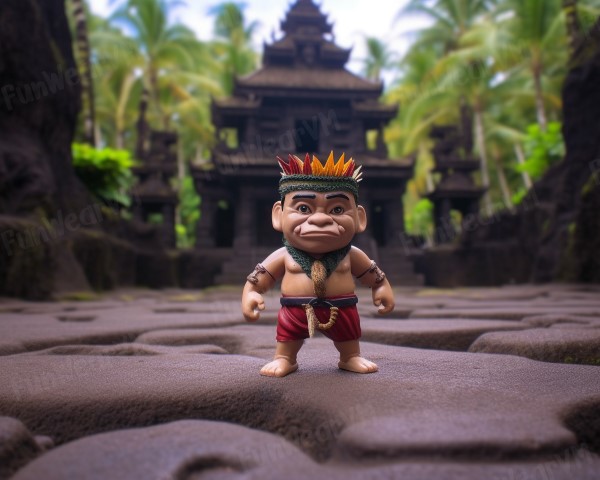
Have you ever wondered who built the ancient stone structures that dot the Hawaiian landscape? Some of them are so impressive that they seem impossible to have been made by human hands. Well, according to Hawaiian folklore, they were not made by humans at all, but by a race of tiny, mysterious beings called the Menehune.
Who are the Menehune?
The Menehune are a mythological race of dwarf people who are said to live in the deep forests and hidden valleys of the Hawaiian Islands, far away from human settlements. They are described as superb craftspeople who can build anything from temples to fishponds to canoes in a single night. They are also skilled musicians and dancers who love to have fun and feast on bananas and fish.
The Menehune are very shy and secretive, and they only come out at night to work on their projects. They avoid being seen by humans, and if they are discovered, they will abandon their work and flee. They also have magical powers that allow them to shape-shift, fly, or disappear at will.
The origin of the Menehune is unclear. Some sources say they are the descendants of the original settlers of Hawaii, who arrived before the Polynesians and were later absorbed or driven away by them. Others say they are purely mythical beings who belong to the realm of spirits and gods. Some even suggest they are aliens or interdimensional travelers who visit Hawaii from time to time.
What did the Menehune build?
There are many structures in Hawaii that are attributed to the Menehune, either by legend or by name. Some of them are:
- The Alekoko Fishpond: This is a large stone-walled pond near Lihue on Kauai that was used to trap and raise fish. According to legend, it was built in one night by 400 Menehune who passed stones along a human chain that stretched 25 miles (40 km) long. The pond is also known as the Menehune Fishpond.
- The Kikiaola Ditch: This is an irrigation canal near Waimea on Kauai that was used to water the taro fields. According to legend, it was dug in one night by the Menehune who used their bare hands and feet to scoop out the earth. The ditch is also known as the Menehune Ditch.
- The Necker Island Structures: These are stone platforms, walls, and shrines on a small, uninhabited island northwest of Hawaii. According to legend, they were built by the Menehune as a place of worship and refuge. The island is also known as Mokumanamana.
- The Pa o ka Menehune: This is a breakwater wall at Kahaluu Bay on Oahu that was used to protect the bay from waves and sharks. According to legend, it was built by the Menehune who used coral and lava rocks from nearby islands. The wall is also known as the Menehune Wall.
- The Ulupo Heiau: This is a temple platform at Kailua on Oahu that was used for religious ceremonies and human sacrifices. According to legend, it was built by the Menehune who used stones from faraway places. The temple is also known as the Menehune Temple.
Are the Menehune real?
The existence of the Menehune is a matter of debate among scholars and historians. Some argue that they are based on historical facts, while others claim they are purely fictional creations.
One argument for their reality is that there is some archaeological evidence that supports their presence in Hawaii. For example, some of the structures attributed to them show signs of pre-Polynesian construction techniques, such as dry-stone masonry and coral-lime mortar. Also, some of the legends mention specific dates and names that correspond to historical records, such as King Kaumualii of Kauai who conducted a census of the Menehune in 1820.
Another argument for their reality is that there is some genetic evidence that suggests their origin. For example, some studies have found traces of Melanesian DNA in some native Hawaiians, indicating a possible pre-Polynesian migration from Southeast Asia. Also, some studies have found evidence of dwarfism in some ancient Hawaiian skeletons, indicating a possible genetic mutation or adaptation.
One argument against their reality is that there is no mention of them in pre-contact Hawaiian mythology or history. For example, none of the early Hawaiian scholars or missionaries who recorded oral traditions and tales ever mentioned the Menehune as a distinct group or race. Also, none of the early European explorers or travelers who visited Hawaii ever reported seeing or hearing about them.
Another argument against their reality is that they are a product of post-contact mythology and adaptation. For example, some scholars suggest that the term “Menehune” was derived from “manahune”, which means “lowly people” or “commoners” in Tahitian and was used by Tahitian invaders to refer to the original Hawaiians they oppressed or displaced. Also, some scholars suggest that the legends of the Menehune were influenced by European folklore of fairies, gnomes, or brownies.
Conclusion
The Menehune are fascinating creatures that capture the imagination and curiosity of many people who visit or live in Hawaii. Whether they are real or not, they represent an important part of Hawaiian culture and history that deserves respect and appreciation.
References:
- https://en.wikipedia.org/wiki/Menehune#Menehune_Fishpond
- https://en.wikipedia.org/wiki/Menehune#K%C4%ABk%C4%ABaola_ditch
- https://en.wikipedia.org/wiki/Necker_Island_(Hawaii)#Structures
- https://en.wikipedia.org/wiki/Menehune#Pa_o_ka_menehune
- https://en.wikipedia.org/wiki/Menehune#Ulupo_Heiau
- https://www.worldhistory.org/Menehune/#:~:text=An%20extensive%20early%20history%20was%20written%20by%20the,census%20of%20Kaua%E2%80%99i%20by%20Kaumuali%E2%80%99i%2C%20the%20ruling%20ali%E2%80%99i
- https://www.sciencemag.org/news/2015/10/mysterious-link-emerges-between-native-americans-and-people-half-globe-away
- https://www.sciencedirect.com/science/article/abs/pii/S0305440315000260
- https://en.wikipedia.org/wiki/Menehune#Research